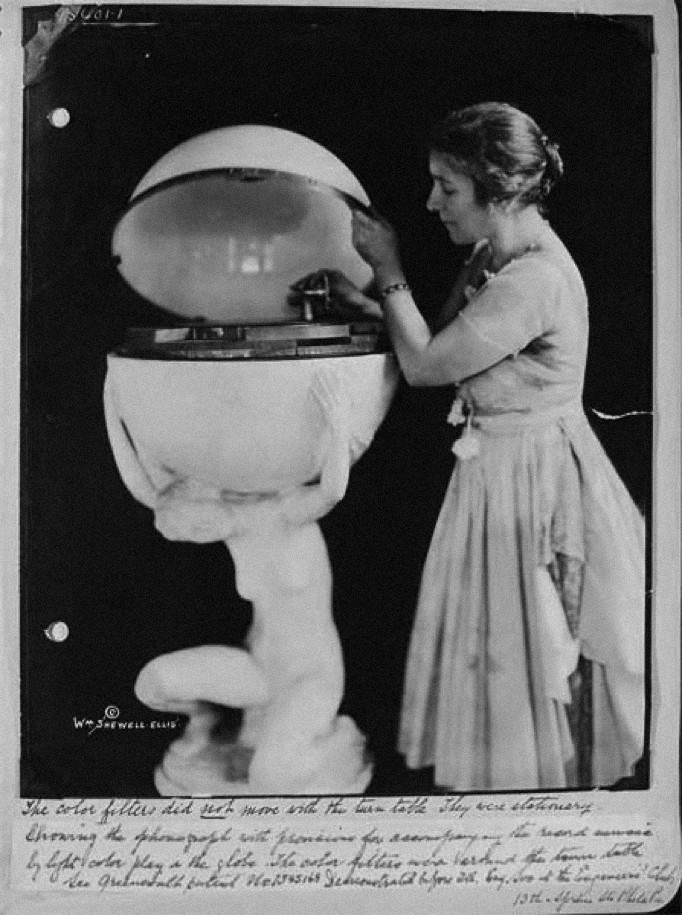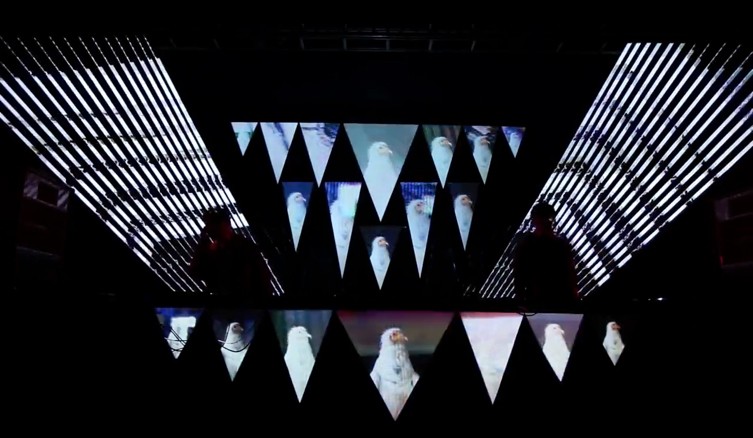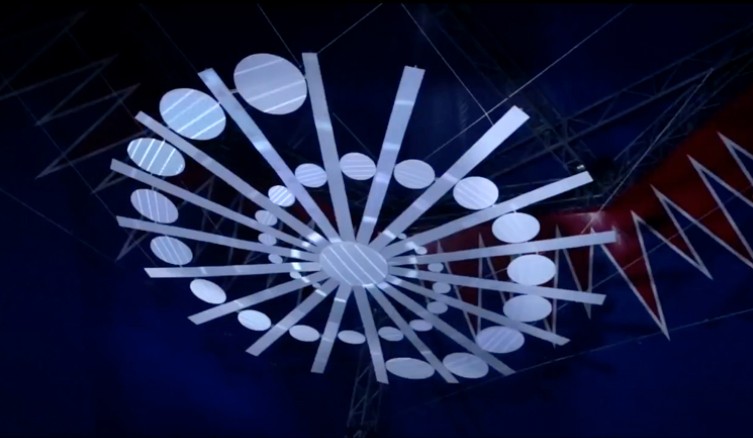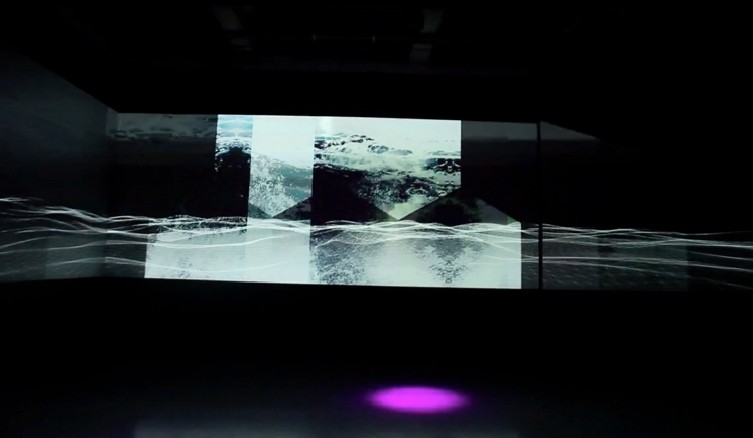LOOK AT
THE SOUND
Thesis
by Ieva Valule2014
5.1 VJ
VJing is somewhat really up-to-date way of a real time performance. Domain Video Jockey or VJ is generally used as a label for artists within the media arts of mixing video clips to music and sound on the fly. It creates some sort of meditative experience for the audience in synchronization to the music. Correlation between the visions of the artist and the experience of the audience is resulting in an augmented experience of the perceived music.
There are a few different approaches to the actual VJing; utilizing a media bank with prepared video loops, the live generation of visual elements from input sources or a hybrid of both techniques. A common workflow is to mix available sources and processing these live using computers and/or controllers
5.2 VJ Mary Hallock-Greenewalt
Mary Hallock-Greenewalt (1871-1951) is best known for her invention of a type of visual music she called Nourathar (Figure 27). The name for her art, Nourathar, was adapted from the Arabic word for light. Unlike the other inventors before, Marry Hallock never referred particular notes to a color. Instead she rather approached and reflected the artist’s ability to perform and their temperament. She always has stated that there is no direct correspondence between a sound and a color.
… There is no octave to color. Color has no harmonics. … Its pristine strength is such that no two colors can fit together as identical. [27]
Mary Hallock was committed to seek deeper connection between the abstract film and visual music performed with the color organs. In total she has patented eleven devices that can create visual music. She was an accomplished musician, but wanted to create an equivalent art form for colour and music.
… There is no octave to color. Color has no harmonics. … Its pristine strength is such that no two colors can fit together as identical. [27]
Mary Hallock was committed to seek deeper connection between the abstract film and visual music performed with the color organs. In total she has patented eleven devices that can create visual music. She was an accomplished musician, but wanted to create an equivalent art form for colour and music.
Michael Betancourt [28] has noted that Hallock-Greenewalt also produced the earliest hand-painted films known to still exist. These movies where not intended to be perceived as independent motion pictures, they were just an ingredient of her color organs - Sarbet. Motion pictures were produced with templates and aerosol sprays, producing and repeating geometric patterns.
According to her, music and visual arts “speak in different ways”, those mediums are always subject to the interpretation of the artist and the experiences of the event. Exactly this statement and her desire to control the ambience in a concert hall make Mary a pioneer VJ.
“Broadly, it is my desire to express emotions by means of timed variations of light and color in a manner analogous to that employed in the art of music. Such expression may either be for its own sake, or … as an accompaniment.” [29]
According to her, music and visual arts “speak in different ways”, those mediums are always subject to the interpretation of the artist and the experiences of the event. Exactly this statement and her desire to control the ambience in a concert hall make Mary a pioneer VJ.
“Broadly, it is my desire to express emotions by means of timed variations of light and color in a manner analogous to that employed in the art of music. Such expression may either be for its own sake, or … as an accompaniment.” [29]
[27] Hallock Greenewalt, Mary. “Nourathar, the fine art of light color playing.” Philadelphia, Pa., Westbrook publishing company, 1946.
[28] Critical theorist, film theorist, art and film historian, and animator. Born 1970.
[29] Hallock Greenewalt, Mary. “Nourathar, the fine art of light color playing.” Philadelphia, Pa., Westbrook publishing company, 1946.
[28] Critical theorist, film theorist, art and film historian, and animator. Born 1970.
[29] Hallock Greenewalt, Mary. “Nourathar, the fine art of light color playing.” Philadelphia, Pa., Westbrook publishing company, 1946.

Figure 27. Mary Hallock Greenewalt with her Visual-Music Phonograph (1919.)
A rococo design, the Sarabet resembles an open egg and rests on the shoulders of a sculpted kneeling woman.
5.3 Art made by machines
Nowadays a VJ most likely deals with the connections between electronic music and different artistic practices. I am exited to see the creative potential of the technology and how it is shaping the modern sense of collectives. Through the rise of the internet adoption and technical possibilities also the electronic and rave festival scene began to regularly include VJs on their main stage.
Also the availability and affordability of new consumer-level technology allowed many people to get involved into VJing. And it is no longer a matter of creativeness or special education that is recquired to visualize music. Especially in last couple of years computer-processing power allows us to execute more complex real time visualization than it was possible in the start of this millennium (Figures 28, 29, 30) All these developments have let us open up new possibilities for a hybridized art and entertainment.



Figure 28, 29, 30.
Limbic Cinema Showreel. Stills from various projects.
From 2010-2014
5.4 Rather technic than design approach
This on-the-fly techinic is impressive by the way it shapes our sense of the collectives and feeling for the combined art forms. In my opinion VJing is a complementary service for a performance that should not overshadow any musical experience. Also somebody who prefers to use this method ideally should have to have a musical background and a strong fascination for both -music and visual arts. I perceive VJing more of a technic of production than a type of design. Artist who has a strong aesthetic vision and sense for visual and audial composition can use this technic to create designs. I guess if I would have to create artwork by using VJing methods it should come from the intuition rather than being based on a story line. Though analysis of the musicians or composers work is a vital first step in order to make sure that the following work is relevant. Additionally the end product should communicate with the listeners and create the metaphysical experience.
One of the aspects why I find it difficult to work this way is the fact that I am not sure about my abilities to give a real time response to the music or sound, since my experience in this field is less than modest. And yet I would also have to spare a time to have a rational contact with the auditory and the performer. During live events, there is not so much time to immediately go deeper in the reflections of the musical piece. Also at times, this kind of real time technic can cause confusion as the mind misinterprets the information from the senses. Even though this particular flaw can be experienced in any method used to interpret music. Overall it is a matter of communication with the audience, giving them what the artist expects them to see in order to get into a certain state of mind.
One of the aspects why I find it difficult to work this way is the fact that I am not sure about my abilities to give a real time response to the music or sound, since my experience in this field is less than modest. And yet I would also have to spare a time to have a rational contact with the auditory and the performer. During live events, there is not so much time to immediately go deeper in the reflections of the musical piece. Also at times, this kind of real time technic can cause confusion as the mind misinterprets the information from the senses. Even though this particular flaw can be experienced in any method used to interpret music. Overall it is a matter of communication with the audience, giving them what the artist expects them to see in order to get into a certain state of mind.
Also practically, this art form can be created and expressed by small cost and great technical efficiency. Further the processing and programming offers to create really complex computer generated graphics, real time video editing and 3d rendering. Within the VJ-scene, technics such as projection mapping are used to augment the illusion of depth from a flat projected image. I think a lot of technical solutions of VJing can be used to create meaningful images, but VJing does not by itself give this meaning to audio visualizations.